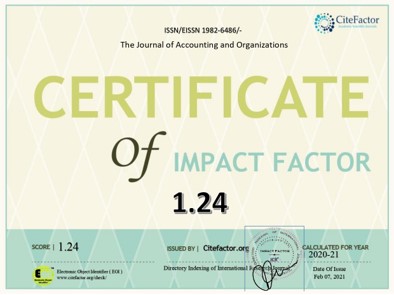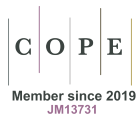Prospects for state credit risk in Brazil: An analysis of the probability of default
DOI:
https://doi.org/10.11606/issn.1982-6486.rco.2022.188194Keywords:
Credit risk, public debt, probability of default, sustainabilityAbstract
As public indebtedness reached record levels in 2021, and economic crises increase public entities’ need for financial loans, credit risk stands out as a useful metric for potential creditors, and for the entities themselves, regarding the management of their liability portfolio. This paper assesses, for the short term, the prospects for state credit risk, focusing on the probability of default. The methods used combine projections resulting from the application of panel data modeling with Monte Carlo simulations, taking as reference concepts related to the sustainability of public entities for determining the risk of default. Results indicate the persistence of a negative condition for most states, and the possibility of grouping entities at different levels of credit risk. In addition, we achieved a practical, alternative, and complementary tool for the analysis of subnational credit risk in the short term.
Downloads
References
Ahmed, S., & Rogers, J. H. (1995). Government budget deficits and trade deficits: are present value constraints satisfied in long-term data? Journal of Monetary Economics, 36(2), 351–374. https://doi.org/10.1016/0304-3932(95)01215-X
Baghdassarian, W. (2006). Avaliação da sustentabilidade fiscal sob incerteza. Cadernos de Finanças Públicas, 7, 31–74. Disponível em: http://repositorio.enap.gov.br/handle/1/3856
Barbosa, L. M. (2018). Sustentabilidade fiscal dos estados brasileiros, 458. Disponível em: https://downloads.fipe.org.br/publicacoes/bif/bif458.pdf
Barnhill, T. M., & Kopits, G. (2003). Assessing fiscal sustainability under uncertainity. In: IMF Working Papers, 03(79). International Monetary Fund. https://doi.org/10.5089/9781451850222.001
Bohn, H. (1998). The behavior of U.S. public debt and deficits. The Quarterly Journal of Economics, 113(3), 949–963. Disponível em: https://www.jstor.org/stable/2586878
Bohn, H. (2007). Are stationarity and cointegration restrictions really necessary for the intertemporal budget constraint? Journal of Monetary Economics, 54(7), 1837–1847. https://doi.org/10.1016/j.jmoneco.2006.12.012
Buiter, W. H., & Patel, U. R. (1992). Debt, deficits, and inflation: an application to the public finances of India. Journal of Public Economics, 47(2), 171–205. https://doi.org/10.1016/0047-2727(92)90047-J
Caldeira, A. A., Wilbert, M. D., Moreira, T. B. S., & Serrano, A. L. M. (2016). Sustentabilidade da dívida estadual brasileira: uma análise da relação dívida líquida e resultado primário. Revista de Administração Pública, 50(2), 285–306. https://doi.org/10.1590/0034-7612151140
Cardoso, V. R. dos S., Pansani, D. A., Serrano, A. L. M., & Wilbert, M. D. (2018). Sustentabilidade da dívida pública: uma análise de curto e longo prazo aplicados aos municípios agregados. Revista Universo Contábil, 14(3), 7–27. https://doi.org/10.4270/ruc.2018317
Chicoli, R. da S., & Bender, S. (2015). Sustentabilidade a dívida pública brasileira: uma análise sob diversos conceitos de superávit primário e endividamento. In: Working Paper Series, 2015(37).
Corsetti, G., & Roubini, N. (1991). Fiscal deficits, public debt, and government solvency: evidence from OECD countries. Journal of The Japanese and International Economies, 5(4), 354–380. https://doi.org/10.1016/0889-1583(91)90004-A
Costa, C. E. E. L. da. (2009). Sustentabilidade da dívida pública. In: Dívida Pública: a experiência brasileira, pp. 81–99. Ministério da Fazenda. Disponível em: https://sisweb.tesouro.gov.br/apex/f?p=2501:9::::9:P9_ID_PUBLICACAO_ANEXO:4718
Cruz, I. D. S. (2020). Fadiga fiscal dos estados brasileiros e a sustentabilidade das dívidas estaduais. Fundação Getúlio Vargas. Disponível em: https://bibliotecadigital.fgv.br/dspace/browse?type=author&value=Cruz%2C+Itanielson+Dantas+Silveira
Garcia, M., & Rigobon, R. (2004). A risk management approach to emerging market’s sovereign debt sustainability with an application to Brazilian data. In: NBER Working Paper Series, 10336(March). https://doi.org/10.7551/mitpress/3759.003.0014
Ghosh, A. R., Kim, J. I., Mendoza, E. G., Ostry, J. D., & Qureshi, M. S. (2013). Fiscal fatigue, fiscal space and debt sustainability in advanced economies. Economic Journal, 123(566), 4–30. https://doi.org/10.1111/ecoj.12010
Hakkio, C. S., & Rush, M. (1991). Is the budget deficit “too large?”. Economic Inquiry, 29(3), 429–445. https://doi.org/10.1111/j.1465-7295.1991.tb00837.x
Hamilton, B. J. D., & Flavin, M. A. (1986). American economic association on the limitations of government borrowing: a framework for empirical testing. The American Economic Review, 76(4), 808–819. Disponível em: https://www.jstor.org/stable/1806077
Lima, L. R., Gaglianone, W. P., & Sampaio, R. M. B. (2008). Debt ceiling and fiscal sustainability in Brazil: a quantile autoregression approach. Journal of Development Economics, 86(2), 313–335. https://doi.org/10.1016/j.jdeveco.2007.11.002
Liu, L., & Waibel, M. (2010). Managing subnational credit and default risks. In: Policy Research Working Paper, 5362(5362). https://doi.org/10.1596/9780821384831_ch11
Luporini, V. (2001). The behavior of the Brazilian federal domestic debt. In: Texto para discussão, 161. https://econpapers.repec.org/paper/cdptexdis/td161.htm
Luporini, V. (2015). Sustainability of Brazilian fiscal policy, once again: corrective policy response over time. Estudos Econômicos, 45(2), 437–458. https://doi.org/10.1590/0101-4161201545247vil
Mello, L. de. (2008). Estimating a fiscal reaction function: the case of debt sustainability in Brazil. Applied Economics, 40(3), 271–284. https://doi.org/10.1080/00036840500461873
Mora, M., & Santos, F. E. de L. e A. (2016). Limites ao endividamento e sustentabilidade fiscal: o caso dos governos estaduais. In: Texto para discussão, 2232. https://www.ipea.gov.br/portal/images/stories/PDFs/TDs/04102016td_2232.pdf
Pereira, R. M. (2020). Fiscal fatigue and public debt limit in Brazil: are we on sustainable path? In: Texto para discussão, 250. https://doi.org/http://dx.doi.org/10.38116/dp250
Pérez, J. J., & Prieto, R. (2015). Risk factors and the maturity of subnational debt: an empirical investigation for the case of Spain. Public Finance Review, 43(6), 786–815. https://doi.org/10.1177/1091142114552840
Potrafke, N., & Reischmann, M. (2015). Fiscal transfers and fiscal sustainability. Journal of Money, Credit and Banking, 47(5), 975–1005. https://doi.org/10.1111/jmcb.12231
Rozenov, R. (2017). Public debt sustainability under uncertainty: an invariant set approach. IMF Working Paper, 17(57). https://www.imf.org/en/Publications/WP/Issues/2017/03/13/Public-Debt-Sustainability-Under-Uncertainty-An-Invariant-Set-Approach-44744
Smith, G. W., & Zin, S. E. (1991). Persistent deficits and the market value of government debt. Journal of Applied Econometrics, 6(1), 31–44. https://doi.org/10.1002/jae.3950060104
Tabosa, F. J. S., Ferreira, R. T., Simonassi, A. G., Khan, A. S., & Tomaz, D. (2016). Reação fiscal ao aumento da dívida pública: uma análise para os estados brasileiros. Economia Aplicada, 20(1), 57–71. https://doi.org/10.11606/1413-8050/ea134918
Torrezan, R. G. A., & Paiva, C. C. de. (2021). A crise fiscal dos estados e o regime de recuperação fiscal: o déjà vu federativo. Revista de Administração Pública, 55(3), 716–735. https://doi.org/htt.doi.org/10.1590/0034-761220200042
Trehan, B., & Walsh, C. E. (1988). Common trends, the government’s budget constraint, and revenue smoothing. Journal of Economic Dynamics and Control, 12(2–3), 425–444. https://doi.org/10.1016/0165-1889(88)90048-6
Wilcox, D. W. (1989). The sustainability of government deficits: implications of the present-value borrowing constraint. Journal of Money, Credit and Banking, 21(3), 291–306. https://doi.org/https://doi.org/10.2307/1992415
Downloads
Published
Issue
Section
License
Copyright (c) 2022 Leonardo Vieira Bortolini, Bruno Pérez Ferreira, Frank Magalhães de Pinho

This work is licensed under a Creative Commons Attribution-NonCommercial-NoDerivatives 4.0 International License.
The RCO adopts the Free Open Access policy, under the standard Creative Commons agreement (CC BY-NC-ND 4.0). The agreement provides that:
- Submission of text authorizes its publication and implies commitment that the same material is not being submitted to another journal. The original is considered definitive.
- Authors retain the copyright and grant the journal the right of first publication, with the work simultaneously licensed under the Creative Commons Attribution License which allows the sharing of the work with acknowledgment of authorship and initial publication in this journal.
- Authors are authorized to take additional contracts separately, for non-exclusive distribution of the version of the work published in this journal (e.g. publish in an institutional repository or as a book chapter), with necessary recognition of authorship and initial publication in this journal.
- Authors are allowed and encouraged to publish and distribute their work online (e.g. in institutional repositories or on their personal page) before or during the editorial process, as this can generate productive changes as well as increase the impact and citation of published work (See The Effect of Free Access).
- The journal does not pay copyright to the authors of the published texts.
- The journal's copyright holder, except those already agreed in the Free Open Access Agreement (CC BY-NC-ND 4.0), is the Accounting Department of the Faculty of Economics, Administration and Accounting of Ribeirão Preto of the University of São Paulo.
No submission or publication fees are charged.
Up to 4 authors per article are accepted. Exceptionally duly justified cases may be reviewed by the Executive Committee of the RCO. Exceptional cases are considered as: multi-institutional projects; manuscripts resulting from the collaboration of research groups; or involving large teams for evidence collection, construction of primary data, and comparative experiments.
It is recommended that the authorship be ordered by contribution of each of the individuals listed as authors, especially in the design and planning of the research project, in obtaining or analyzing and interpreting data, and writing. Authors must declare the actual contributions of each author, filling the letter to the editor, at the beginning of the submission, taking responsibility for the information given.
Authors are allowed to change throughout the evaluation process and prior to the publication of the manuscript. The Authors should indicate the composition and final order of authorship in the document signed by all those involved when accepted for publication. If the composition and authoring order is different than previously reported in the system, all previously listed authors should be in agreement.
In the case of identification of authorship without merit or contribution (ghost, guest or gift authorship), the RCO follows the procedure recommended by COPE.







